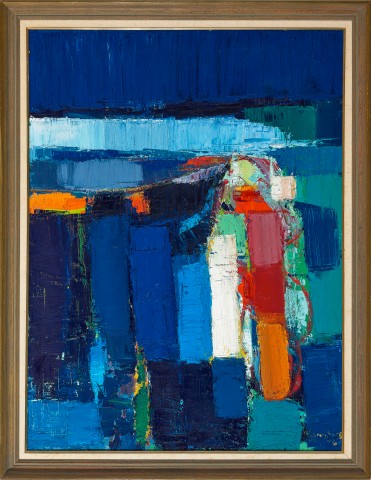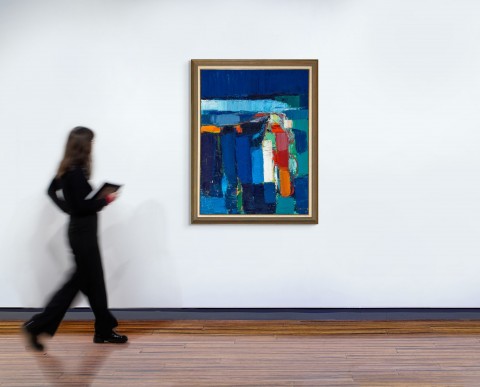PT D’ENTRECASTEAUX, 1976
GUY GREY-SMITH
oil and beeswax on composition board
121.0 x 91.0 cm
signed and dated lower right: G Grey Smith / 76
bears inscription on frame verso: GUY GREY-SMITH 'ANN LEWIS' 1978
inscribed verso: 31
Estate of the artist
Gallery 52, Perth
Private collection, Perth, acquired from the above in 1982
A Festival of Perth Exhibition: Paintings by Guy Grey-Smith, Old Fire Station Gallery, Perth, 24 February – 16 March 1977, cat. 31
Gaynor, A., Guy Grey-Smith: Life Force, University of Western Australia, Perth, 2012, p. 266
Guy Grey-Smith is renowned for his powerful visions of the Western Australian landscape, in particular the rocky coasts of the south-west. This love of the sea was instilled in him as a child, travelling over two hundred kilometres with his family for holidays at places like Bunkers Bay and Canal Rocks. These journeys, occasionally by horse and cart, also took in the variety of the natural world as they passed through woodland, fields of wildflowers and soaring karri forests. In Pt D’Entrecasteaux, 1976, Grey-Smith stands 240 kilometres further south at Black Point (now known as Tookulup), a small promontory that looks towards the spectacular Point D’Entrecasteaux, named after the French Admiral who was the first European to sight the area in 1792.
Coastal paintings appear at most stages of Grey-Smith’s trajectory and following them consecutively, they provide signposts as his technique altered to become the celebrated slab paintings of the 1960s and 1970s. Early works such as Albany Landscape (Torbay), 1951 (private collection), and Longreach Bay, Rottnest, 1954 (Art Gallery of Western Australia) are descriptive of the rhythms and natural patterns of the ocean but are still, even placid, when compared to the spiky rock outcrops in Bunker Bay (Winter), 1956 (private collection) and Bunker Bay, 1960 (private collection). Conversely, in Kalbarri Landscape, 1959 (Artbank), the crash of the waves and the surge of the rolling surf resonate throughout the scene. Abandoning the theme for much of the 1960s, Grey-Smith returned in the mid-1970s with a passionate sequence of paintings done in his (by-now) trademark process of pigment thickened with a home-made wax emulsion applied using paint scrapers. The work on offer here, Pt D’Entrecasteaux, 1976, belongs to this series and it appears that Grey-Smith has climbed down just below the summit of Black Point, as the lower half of the painting is highly suggestive of the heavily eroded rock forms within the one-hundred-metre-high limestone cliff. This upthrust is then counterbalanced by the horizontality of Point D’Entrecasteaux itself, rendered as a ghostly blue apparition cutting left to right above. Suggestive of a primaeval life force, Grey-Smith succeeds here in ‘divorcing abstraction from romantic self-expression… (his) concern is with the thing, and its value to other observers, and not primarily with the autobiography of (his) own feelings. This kind of classical abstractionism is perhaps more valuable than romantic abstract expressionism, and harder to come by.’1
Pt D’Entrecasteaux was exhibited at Grey-Smith’s remarkable exhibition of 1977 held at Rie Heyman’s Old Fire Station Gallery in Subiaco, Perth, full of ‘glorious colour which seemed to pour out of the gallery as we walked up the street.’2 To coincide with the show, Art and Australia published an extended article by noted curator Barry Pearce who celebrated that the artist was deliberately pushing his own boundaries, which was ‘typical of the energetic character of Guy Grey-Smith in seeking to improve and extend the possibilities of his subject without plagiarising himself, and there is no sign of relaxation of his prolific output.’3 Grey-Smith died in 1981 after two equally powerful exhibitions mounted by Ann Lewis at Gallery A in Sydney; and the current owners purchased Pt D’Entrecasteaux from respected Perth gallerist Wendy Rogers in 1982. It has not been seen publicly since.
1. Hutchings, P., ‘The Grey-Smiths’, The Critic, Perth, vol. 2, no. 10, 25 May 1962, p. 82
2. Thomas, C.V., cited in Gaynor, A., Guy Grey-Smith: life force, University of Western Australia Publishing, Perth, 2012, p. 104
3. Pearce, B., ‘Guy Grey-Smith: painter in isolation’, Art and Australia, vol. 15, no. 1, 1977, p. 69
ANDREW GAYNOR


